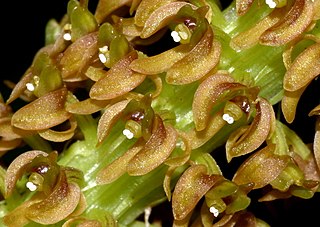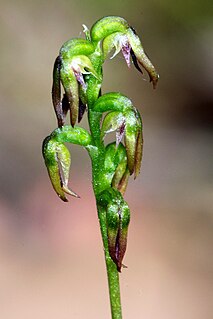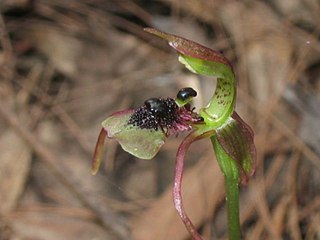
Crepidium, commonly known as 沼兰属 or spur orchids is a genus of about three hundred species of orchids in the family Orchidaceae. Plants in this genus are evergreen, mostly terrestrial plants with short stems lying on the ground, two or more relatively large, pleated leaves and small, non-resupinate flowers with spreading sepals and petals. The genus is widely distributed in the tropics.

Dienia ophrydis, commonly known as the common snout orchid or 无耳沼兰 is a plant in the orchid family and is native to endemic to a broad area of Asia, Southeast Asia, the Philippines, New Guinea and northern Australia. It is a deciduous, terrestrial orchid with a cone-shaped stem, bright green, wavy leaves and many greenish, brown, reddish or purplish flowers crowded on a wiry flowering stem.

Pterostylis bicolor, commonly known as the black-tip greenhood, is a plant in the orchid family Orchidaceae and is endemic to south-eastern Australia. It has a rosette of leaves and when flowering, three to ten well-spaced, bright green flowers with a blunt, greenish-black appendage on the labellum. It is similar to the swan orchid, Pterostylis cycnocephala but that species has a beak-like appendage and crowded flowers.
Pterostylis conferta, commonly known as the leprechaun greenhood or basalt midget greenhood, is a plant in the orchid family Orchidaceae and is endemic to Victoria. It has a rosette of leaves at the base of the flowering stem and up to sixteen pale green flowers in a short, crowded spike. It is a very rare orchid, similar to P. mutica, its distribution much reduced by urbanisation and agriculture.

Prasophyllum caudiculum, commonly known as the Guyra leek orchid, is a species of orchid endemic to a small area of northern New South Wales. It has a single tubular, bright green leaf and up to thirty five greenish to reddish-brown flowers crowded along an erect flowering stem. It grows in grassy places near Guyra.

Genoplesium despectans, commonly known as the sharp midge orchid and known as Corunastylis despectans in Australia, is a small terrestrial orchid endemic to south-eastern Australia. It has a single thin leaf fused to the flowering stem and up to forty five small, dark purple or green and purple flowers.
Corunastylis nigricans, commonly known as the Kangaroo Island midge orchid is a small terrestrial orchid endemic to South Australia. It has a single thin leaf and up to twenty five purplish brown flowers with a shiny, hairless, dark purplish labellum. It is sometimes confused with Genoplesium nigricans which has differently coloured flowers and a much wider distribution. It is regarded as a synonym of G. nigricans by the World Checklist of Selected Plant Families.
Genoplesium morinum, commonly known as the mulberry midge orchid and as Corunastylis morina in Australia, is a small terrestrial orchid endemic to New South Wales. It has a single thin leaf fused to the flowering stem and up to twenty crowded, dark reddish purple flowers. It has been known as "mulberries on sticks".
Genoplesium turfosum, commonly known as the alpine midge orchid, is a small terrestrial orchid endemic to a small area in the higher parts of New South Wales. It has a single thin leaf fused to the flowering stem and up to twenty five dark purplish-red, crowded flowers with a sparsely hairy labellum.
Corunastylis densa, commonly known as the dense midge orchid, is a small terrestrial orchid endemic to eastern Australia. It has a single thin leaf fused to the flowering stem and up to twenty five densely crowded reddish-brown to dark purplish-brown flowers. It is found between the New England National Park and the Moroka River.

Chiloglottis seminuda, commonly known as the turtle orchid, is a species of orchid endemic to south-eastern New South Wales. It has two broad leaves and a single green or reddish pink flower with a shiny black insect-like callus covering two-thirds of the base of the labellum but with the tip of the labellum free of callus.
Chiloglottis trullata, commonly known as the triangular orchid, is a species of orchid endemic to Queensland. It has two dark green leaves and a single small, green or pinkish flower with a shiny, dark reddish black, insect-like callus surrounded by reddish club-shaped calli covering most of the upper surface of the labellum.
Arthrochilus corinnae, commonly known as the swamp elbow orchid, is a flowering plant in the orchid family (Orchidaceae) and is endemic to the northern part of Cape York in Queensland. It has two or three dull bluish green leaves near its base and up to twelve pale green, insect-like flowers with shiny yellowish glands on its labellum.

Crepidium fimbriatum, commonly known as the fringed spur orchid, is a plant in the orchid family and is endemic to tropical Far North Queensland. It is an evergreen, terrestrial orchid with a fleshy stem, wavy leaves and many purple flowers crowded on a purple flowering stem.
Crepidium flavovirens, commonly known as the green spur orchid, is a plant in the orchid family and is endemic to tropical far North Queensland. It is an evergreen, terrestrial orchid with a fleshy stem, wavy leaves and many yellowish green flowers crowded on a green flowering stem.
Crepidium fontinale, commonly known as the yellow spur orchid, is a plant in the orchid family and is endemic to the Northern Territory. It is an evergreen, terrestrial orchid with a fleshy stem, wavy leaves and many yellowish green flowers crowded on a green flowering stem.

Crepidium lawleri, commonly known as the small spur orchid, is a plant in the orchid family and is endemic to tropical far north Queensland. It is an evergreen, terrestrial orchid with an upright stem, dark green leaves and up to ten greenish cream-coloured flowers well spaced along a brittle flowering stem.
Tainia trinervis, commonly known as the ribbon orchid, is an evergreen, terrestrial plant with crowded pseudobulbs, each with a single smooth, shiny leaf and up to fourteen greenish to yellowish flowers with red or purplish stripes in the middle. It is found in tropical Southeast Asia, New Guinea and northern Australia.
Tropidia territorialis, commonly known as the striped crown orchid, is an evergreen, terrestrial plant with between three and six thin, pleated, dark green leaves and up to twenty crowded, green and white flowers. It is only known from about five places in the Northern Territory, Australia.

Robiquetia wassellii, commonly known as the green pouched orchid, is an epiphytic or lithophytic orchid from the family Orchidaceae. It has thick roots, a pendulous stem, between three and six crowded, dark green leaves and many crowded dark green flowers with pink to red centres and a white to yellowish labellum. It grows on trees and rocks in rainforest in tropical North Queensland, Australia.









